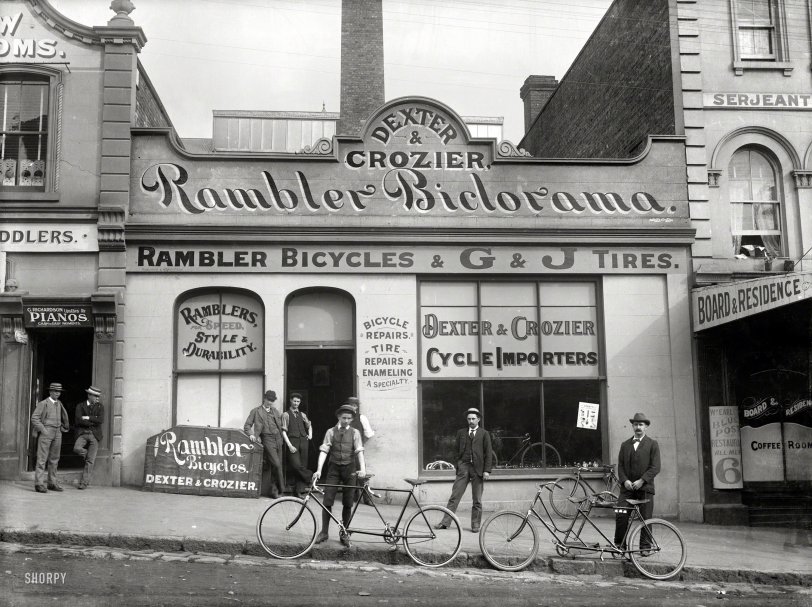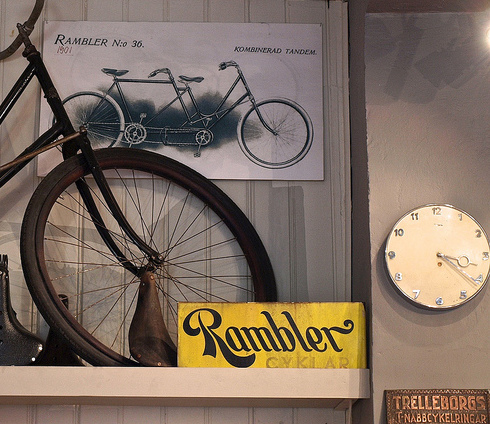


Framed or unframed, desk size to sofa size, printed by us in Arizona and Alabama since 2007. Explore now.
Shorpy is funded by you. Patreon contributors get an ad-free experience.
Learn more.

- Baldwin 62303
- Baldwin VO-1000
- Cold
- No expense spared
- Tough Guys
- Lost in Toyland
- And without gloves
- If I were a blindfolded time traveler
- Smoke Consumer Also Cooks
- Oh that stove!
- Possibly still there?
- What?!?
- $100 Reward
- Freeze Frame
- Texas Flyer wanted
- Just a Year Too Soon
- WWII -- Replacing men with women at the railroad crossing.
- Yes, Icing
- You kids drive me nuts!
- NOT An Easy Job
- I wonder
- Just add window boxes
- Icing Platform?
- Indiana Harbor Belt abides
- Freezing haze
- Corrections (for those who care)
- C&NW at Nelson
- Fallen Flags
- A dangerous job made worse
- Water Stop
Print Emporium
Rambler Biclorama: 1902

Auckland, New Zealand, 1902. "Dexter & Crozier, cycle importers, Victoria Street East." Glass negative by James Hutchings Kinnear. View full size.
Rambler logos
It's interesting to see how many ways the Rambler logo is interpreted in that single scene. Brand identities were much more flexible back then. I spotted yet another Rambler logo in a Stockholm bike shop a few years ago.

Demolished?
There appears to be nothing left of the buildings shown. I went to Victoria Street East yesterday and carefully looked for remnants, but saw none. I suspect the cycle shop and the buildings on each side were demolished long ago, the site now being occupied by the Lister Building.
Opposite ends of the tandem spectrum
These bikes represent the two extremes of turn-of-the century tandems. The bike on the right would have been most at home pootling down a garden path, while the one on the left was built for the velodrome.
fastRfastR is quite right that the bike on the right with the leather chainguard is a rear-steered courting tandem. This was probably the most common tandem configuration in the 1890s.
While the bike on the right is built for leisure, the one on the left is a speed machine that concedes little to comfort, especially for the stoker. While tandems were raced on the track in their own right, they were more often used as pace bikes. In certain types of trials, tandems, triplets and even quads and quints "towed" bikes up to speed in their slipstream before the final laps.
The "skip-link" chainring on the track bike was not uncommon on racing bikes into the 1940s. Alternating short and long links allows the use of stronger, higher profile teeth on the chainring than is possible with a standard chain, which in turns means fewer broken teeth for both bike and rider.
Hilly
Bill T. said: "Never locate a bicycle shop on a hill."
You don't know Auckland! It's hilly almost everywhere in the CBD, except for Fort Street, Customs Street, and Quay Street, which are all built on land reclaimed from the harbour.
Dexter & Crozier
From The Cyclopedia of New Zealand:
The business premises contain a large show-room, with offices at the front, and behind there is a large repairing shop, with lathes, a forge, and brazing and enamelling plant.
Blind Bust
The head to the left of the piano sign is very interesting with the eyes covered with a wrapping, odd indeed.
A franchise?
At about this time there was apparently another "Biclorama" located in San Francisco. It was billed as "Thos. H.B. Varney's Rambler Biclorama: The Largest and Most Complete Bicycle Establishment in the World." Specifics are scarce, but some material is available from Google in printed form only.
Never locate a bicycle shop on a hill. The considerable extra energy required to pedal up hill can be too much of a reality check for a newbie cyclist.
Courting Tandem!
The tandem to the right has a curious frame: a few more tubes than usual; step-through frame in front; parts going from the fork to the rear rider! An initial google search for 'tandem stoker steering' yielded the term 'courting tandem'. Search that for description, photos and antique bikes for sale. Is that a leather chainguard at the front chainwheel?
Chainwheel of the left, uphill tandem is interesting: a very large tooth pitch. Chain looks pretty normal, though. One tooth per three links?
The Tandem on the Right
The tandem on the right appears to be steerable from the stoker position, but I'm having trouble understanding the geometry. I've never seen such a configuration. Can anyone help a brother out with an explanation?
The Coffee Room
Yeah right, like anyone will ever make money just selling cups of Coffee.
... on a bicycle built for two, or maybe three?
interesting, the first bike has the more modern low set handlebars one associates with racing bikes. I can't help but feel sorry for the person sitting in the second seat if the first has some digestive problems.
The second bike however has the step-through frame more commonly associated with ladies' bikes in the first position, with the step-over bar for a gentleman in the second position. Both are equipped with the "sit up and beg" style handlebars. I'm trying to decide if there is a saddle or at least a seatpad on the crossbar in the second position - perhaps for a child?
Rambler bikes and cars
These Rambler bikes came from the Gormully and Jeffery Mfg. Co. of Chicago. By the time the instant image was snapped, Thomas Jeffery was in his 5th year of producing automobiles. In 1901 he introduced the Model A Rambler, a name that would much later be tied to Nash products. The G and J (Gormully and Jeffery) Tire Co. sponsored two races at the Indianapolis Speedway prior to the first 500 in 1911.
Backseat driver
Two tandems and the one on the right seems to have an arrangement that allows it to be steered from the rear seat.
A touch of home
A sad looking houseplant on a windowsill of the Board & Residence hotel.
























On Shorpy:
Today’s Top 5